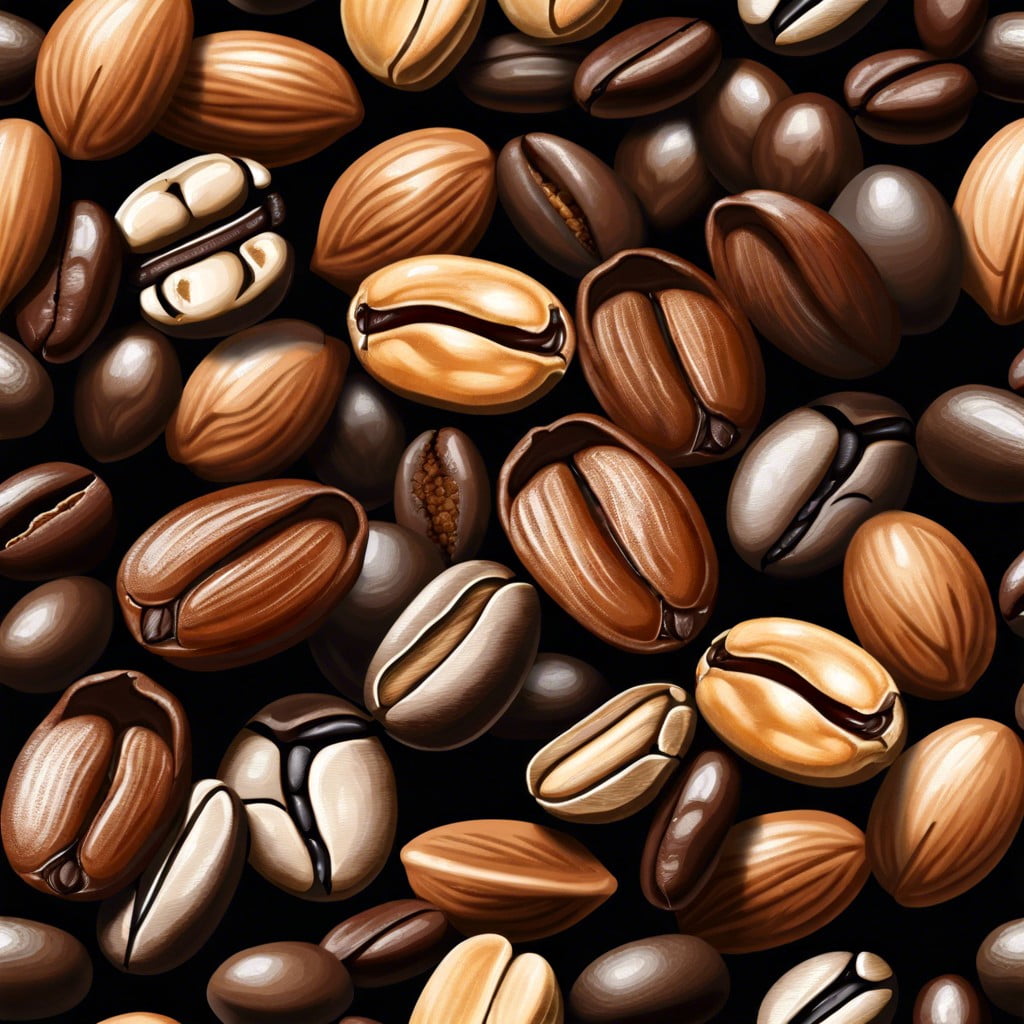Discover the fascinating world of coffee beans, from their unique types and flavors to tips on selecting the perfect roast for your taste.
Arabica Vs. Robusta

Arabica beans boast a delicate, nuanced flavor – think fruity, floral, and sometimes nutty notes. They prefer high altitudes and cooler climates. Their low caffeine content means less bitterness.
Robusta beans, on the other hand, pack a punch. Strong, bold, and with a hint of chocolate, they have nearly double the caffeine of Arabica. They thrive in hotter, harsher environments.
When choosing your bean, think of it as picking a dance partner: Arabica is the elegant waltz, while Robusta is the fiery tango. Each has its own charm, so why not try both and see which one gets your taste buds grooving?
Processing Methods
Let’s dive into how our beloved coffee beans transform from humble cherries into the magic beans that fuel our days.
First up, we have the natural or dry process. Imagine sunbathing on a tropical beach—only it’s the coffee cherries doing the lounging. They’re left out to dry with all their fruity bits still attached, soaking up the sun until they’re ready to shed their skins. This method gives us those sweet, fruity flavors.
Next is the washed or wet process. Think of it as a spa day for coffee beans: a soak, a scrub, and a polish. The cherries are de-pulped and fermented to remove the mucilage. Once they’re squeaky clean, they’re dried. This process often highlights the bean’s acidity and produces a cleaner cup.
Lastly, ever heard of the honey process? No actual honey involved, I promise. It’s more of a hybrid. The cherries are de-pulped but some mucilage stays. The beans are then dried, resulting in a balance of the fruity notes from the natural process and the clarity from the washed process.
There you have it—three methods, three paths to flavor bliss. Each process has a unique impact on the taste and complexity of your cup.
Distribution Regions
Coffee beans thrive in the so-called “Bean Belt”, the tropical region between the Tropic of Cancer and the Tropic of Capricorn. This region serves up the perfect climate conditions for cultivating coffee.
Central and South America are heavy hitters. Brazil, the undisputed heavyweight, churns out a third of the world’s coffee. Colombia’s beans? As smooth as its salsa moves.
Africa, particularly Ethiopia and Kenya, brings magic to the cup with beans bursting with fruity and floral notes. If coffee were a fruit salad, African beans would be the zesty citrus adding zing.
Asia? Don’t count it out. Vietnam’s Robusta beans pack a punch, fueling your morning like a caffeine-powered rocket. Indonesia, another star, offers beans like Sumatra and Java, full-bodied and complex, perfect for a bold brew.
Each region stamps its own terroir onto the beans, creating a world tour in every cup.
Historical Background
Once upon a time, coffee beans were discovered by goats. Yes, you read that right! Legend has it that in the Ethiopian highlands, a herd of goats had a bit too much energy after munching on some mysterious red cherries.
Fast forward to the 15th century, and coffee had found its way to the Arabian Peninsula. Coffeehouses popped up like modern-day Starbucks, becoming the epicenters for socializing, intellectual debate, and trade negotiations.
By the 17th century, coffee had invaded Europe’s shores. It was initially met with suspicion and labeled as “the bitter invention of Satan.” Luckily, that stigma didn’t last long. Coffeehouses sprouted all over and even earned the nickname “penny universities” because for a penny, you could get a coffee and engage in stimulating conversation.
Next stop: South and Central America. In the 18th century, coffee cultivation spread to these regions, thanks to some adventurous—or perhaps caffeine-addicted—European colonists.
So, from energizing goats to becoming a global staple, the journey of coffee beans is nothing short of legendary.
Impact of Climate On Coffee Beans
Coffee beans are sensitive creatures; they thrive in very specific climates. Temperature needs to be just right. Think Goldilocks: too hot or too cold can spoil the fun. Ideally, we’re looking at a range between 60°F to 70°F.
Rainfall also plays a starring role. Coffee plants guzzle about 60 inches of water annually. Too much rain, and they’ll drown; too little, and they might shrivel up like a forgotten raisin.
Altitude is the unsung hero behind those rich flavors. Higher altitudes bring cooler temperatures, which slow down the maturation process, allowing the beans to develop a richer profile. So next time you sip that exquisite latte, remember it might owe its depth to its mountain heritage.
But alas, climate change is the villain in our story. Unpredictable weather patterns and shifting temperatures can wreak havoc on coffee crops, leading to lower yields and affecting flavor. Scary stuff, right? This shows just how crucial maintaining stable climates is for the future of our beloved brew.